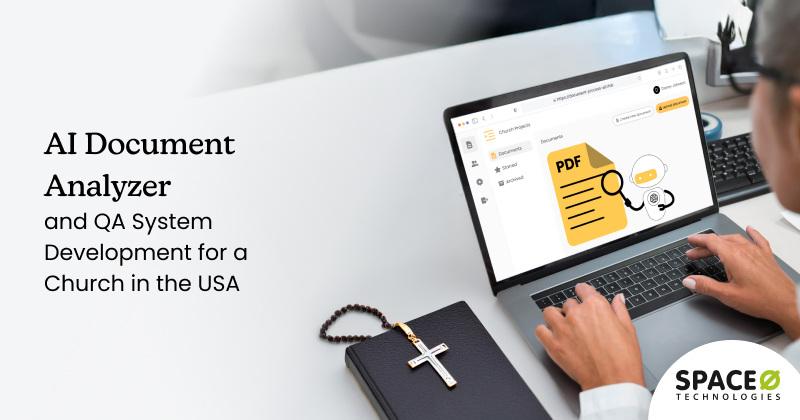
| Industry | Build Time | Platform | Solution We Provided |
|---|---|---|---|
| Education | 3 months | Web Application | AI-based Software Development Services |
Our client is a highly revered priest in one of the United States’ most esteemed churches. This church originated in New Jersey and has since expanded to several states, gaining thousands of dedicated followers.
Our client faced significant problems managing this large number of followers, especially during Bible study group sessions and Sunday briefings. To address those problems, they sought our guidance in developing a platform that leverages AI.
This case study will help you understand the software solution we provided them: an AI-powered document analyzer and QA system.
Before delving into the solution, we will highlight some key challenges our client cited.
When our clients approached us, they presented challenges faced by their church and fellow followers. Some of the key challenges they cited were:
To overcome these challenges and make Bible studies accessible to all, our client came with certain requirements.
Our client approached us with many requirements, including:
Do you have a similar requirement? Contact our top AI consultants to get started.
We discussed some of the most notable client requirements; now, let us proceed to discuss the solution we provided.
When our client, the head priest, contacted us for the development of an AI-powered document analyzer with an integrated QA system, our team, backed by years of experience delivering similar projects quickly understood the assignment.
After thoroughly analyzing their requirements and project expectations, we designated a team of five members to build the requested solution. The team included a ReactJS developer, a NodeJS developer, a QA analyst, a UI designer, and a project manager.
We created an AI document analyzer and QA system for our client that accommodates two stakeholders, namely, Admin and Followers. Our team used the following technologies to develop this software solution:
These were key tools our team used to develop the requested software solution. Proceeding further, allow us to summarize the solution we provided:
The AI document analyzer and QA system is a revolutionary solution in the realm of religious and faith-based technology. This platform enables the USA-based church to spread its teachings and answer the religious queries of a wider audience.
How it works?
Any priest or admin can upload or create documents, such as Bible study session notes or Sunday Mass briefings. After the document is uploaded or created, the AI-powered document analyzer processes it and generates vector embeddings. The admin can also assign specific labels and sub-labels to categorize these documents into various sections.
Once a document is analyzed, an AI chatbot for that document gets activated, enabling it to answer contextual questions. The admin can then share this chatbot with followers using the “Share Chatbot” provision.
With access to this chatbot, followers can resolve their queries about Bible study sessions or mass briefings effortlessly at their convenience. This software thus makes it easier for the followers to comprehend the briefings.
This is all about how our solution works. Now, it’s time we brief you on some of the notable outcomes of this solution.
The AI document analyzer and QA system delivered promising results to our clients, helping them share their wisdom with a broader audience. Some of the most notable outcomes include:
Before we discuss the software’s key functionalities, let’s first summarize the technology stack we used for this project.
| Technology | Use |
|---|---|
| ReactJS | Front-end development |
| NodeJS | Back-end development |
| PostgreSQL and Redis | Database management and quick data extraction |
| OpenAI ChatGPT | For document analysis and chat facility |
Moving further, we will brief you on some key functionalities this software boasts for the end-users.
These were some key functionalities of the AI document analyzer and QA system. Next, allow us to brief you on our future plans.
To make the AI-powered document analyzer and QA system more efficient and productive, we have the following plans:
Does your company need a similar AI-powered software solution developed by global talents? Hire our offshore AI developers to transform your idea into a practical solution–within your budget.
A custom AI document analyzer and QA system is a game-changing solution that can help businesses analyze documents faster, significantly reducing time and labor costs. Such software can prove a turning point for various industries, including legal, healthcare & medical research, government, education, real estate, and property management.
These industries handle large volumes of documents and research materials, which, when processed manually, can be highly time-consuming. For instance, consider complex legal documents, such as contracts, which are lengthy for legal professionals to process and difficult for an average person to understand.
In such scenarios, AI-powered document analysis and QA systems can help users analyze and understand complex business documents effortlessly.
Looking for an AI Software Solution to Optimize Your Business Operations?
Contact us. We can build efficient and productive AI-powered software solutions that foster innovation and optimize business operations.